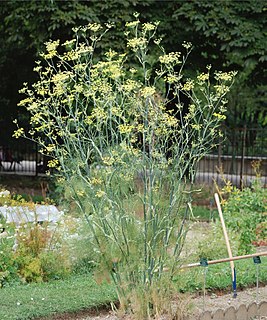
Fennel is a flowering plant species in the carrot family. It is a hardy, perennial herb with yellow flowers and feathery leaves. It is indigenous to the shores of the Mediterranean but has become widely naturalized in many parts of the world, especially on dry soils near the sea-coast and on riverbanks.
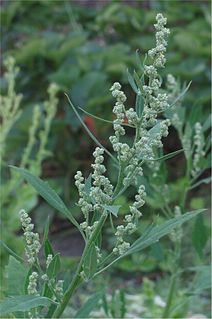
Chenopodium album is a fast-growing weedy annual plant in the genus Chenopodium. Though cultivated in some regions, the plant is elsewhere considered a weed. Common names include lamb's quarters, melde, goosefoot, manure weed, wild spinach and fat-hen, though the latter two are also applied to other species of the genus Chenopodium, for which reason it is often distinguished as white goosefoot. Chenopodium album is extensively cultivated and consumed in Northern India as a food crop known as bathua.

Althaea officinalis, or marsh-mallow, is a perennial species indigenous to Europe, Western Asia, and North Africa, which is used in herbalism and as an ornamental plant. A confection made from the root since ancient Egyptian times evolved into today's marshmallow treat, but most modern marshmallow treats no longer contain any marsh-mallow root.

Chayote, also known as mirliton, choko, tayota, chocho (Jamaica), and chuchu (Brazil), is an edible plant belonging to the gourd family, Cucurbitaceae. Chayote was one of the several foods introduced to the Old World during the Columbian Exchange. Also during this period, the plant spread from Mesoamerica to other parts of the Americas, ultimately causing it to be integrated into the cuisine of many other Latin American nations.
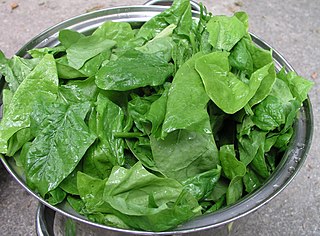
Leaf vegetables, also called leafy greens, salad greens, pot herbs, vegetable greens, or simply greens, are plant leaves eaten as a vegetable, sometimes accompanied by tender petioles and shoots. Although they come from a very wide variety of plants, most share a great deal with other leaf vegetables in nutrition and cooking methods.

Ipomoea aquatica is a semi-aquatic, tropical plant grown as a vegetable for its tender shoots and it is not known as to where it originated. This plant is known in English as water spinach, river spinach, water morning glory, water convolvulus, or by the more ambiguous names Chinese spinach, Chinese watercress, Chinese convolvulus or swamp cabbage, or kangkong in Southeast Asia and ong choy in Cantonese.

Glebionis coronaria, formerly called Chrysanthemum coronarium, is a species of flowering plant in the daisy family. It is native to the Mediterranean region. It is cultivated and naturalized in East Asia and in scattered locations in North America.
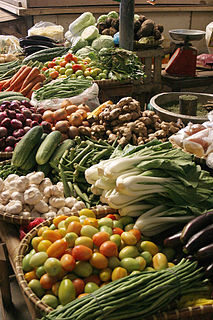
Vegetables are parts of plants that are consumed by humans or other animals as food. The original meaning is still commonly used and is applied to plants collectively to refer to all edible plant matter, including the flowers, fruits, stems, leaves, roots, and seeds. The alternate definition of the term is applied somewhat arbitrarily, often by culinary and cultural tradition. It may exclude foods derived from some plants that are fruits, flowers, nuts, and cereal grains, but include savoury fruits such as tomatoes and courgettes, flowers such as broccoli, and seeds such as pulses.

Abelmoschus caillei, the West African okra, is a plant species in the family Malvaceae. It occurs in humid areas of West and Central Africa, where it is used as a vegetable. It originated as an allopolyploid hybrid of Abelmoschus esculentus and A. manihot, and is often mistaken for either of those two plants. It was officially described elevated to the status of a species in 1988. The same hybrid was produced experimentally in Japan where it is known as Abelmoschus glutino-textile.
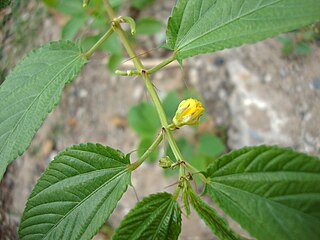
Jute mallow or nalta jute is a species of shrub in the family Malvaceae. Together with C. capsularis it is the primary source of jute fiber. The leaves and young fruits are used as a vegetable, the dried leaves are used for tea and as a soup thickener, and the seeds are edible.

Alternanthera sessilis is an aquatic plant known by several common names, including Matikaduri (মাতিকাদুৰী) in Assamese, ponnanganni, ponnaganti aaku, honnagone, mukunuwenna, sessile joyweed and dwarf copperleaf. It is used as a vegetable specially in Sri Lanka and some Asian countries.

Neglected and underused crops are domesticated plant species that have been used for centuries or more for their food, fibre, fodder, oil or medicinal properties, but have been reduced in importance over time. A wide range of terminology is used to describe these crops, including: orphan, abandoned, lost, underutilized, local, minor, traditional, alternative, niche, or underdeveloped; in recent fashion, these are often referred to as forgotten or smart food. Reductions in use may pertain to, among other things: supply or consumption constraints, poor shelf life, unrecognized nutritional value, poor consumer awareness, and reputational problems. Some crops have been so neglected that genetic erosion of their genepools has become so severe that they are often regarded as lost crops.

The lists of cultivars in the table below are indices of plant cultivars, varieties, and strains. A cultivar is a plant that is selected for desirable characteristics that can be maintained by propagation.
The following outline is provided as an overview of and topical guide to herbs and spices:

Foodscaping is a modern term for the practice of integrating edible plants into ornamental landscapes. It is also referred to as edible landscaping and has been described as a crossbreed between landscaping and farming. As an ideology, foodscaping aims to show that edible plants are not only consumable, but can also be appreciated for their aesthetic qualities. Foodscaping spaces are seen as multi-functional landscapes which are visually attractive and also provide edible returns.

This is a categorically-organized list of foods. Food is any substance consumed to provide nutritional support for the body. It is produced either by Plants or Animals, and contains essential nutrients, such as carbohydrates, fats, proteins, vitamins, or minerals. The substance is ingested by an organism and assimilated by the organism's cells in an effort to produce energy, maintain life, or stimulate growth.
Multilingual Multiscript Plant Name Database (MMPND) is a multilingual database of names of taxa of plants.















